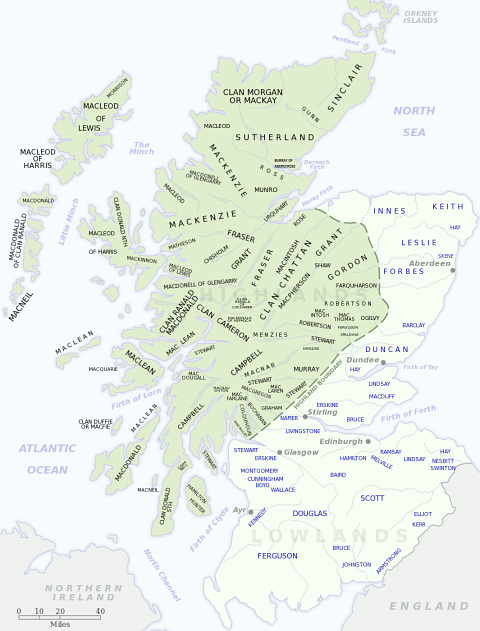
Motto: Sans Peur (Without Fear)
Historic Seat: Dunrobin Castle
District: Sutherland
Associated Surnames: Cheney, Cheyne, Clyne, Duffus, Federith, Gray, Keith, Norman, O'May, O'Shaig, O'Shannachan, O'Shannaig, Oliphant, Park
Associated Tartans:
Early Sutherland Genealogy and History:
(Excerpt from "The Scottish Clans and Their Tartans", James Grant, 1906)
This tribe is descended from the remnants of the Celtic population who retired before the Scandinavian invaders; and Hugh, designed the son of Friskin, is said to have obtained a charter of the clan territory from William the Lion in 1197, and was the founder of the powerful line of Sutherland. To this Hugh, Douglas gives several predecessors, taken from Gordon's "History of Suther," and other writers.
Hugh's son William was created Earl of Sutherland before 1236, and died in 1248.
William, second Earl of Sutherland, in the reign of Alexander II, won another victory over the Danes and Norwegians at a place called Ree-cross, where the Danish leader was buried. William, third Earl, fought at Bannockburn,1 and was one of the nobles who in 1320 signed the famous letter to the Pope, asserting the independence of the Crown. His son, Earl Kenneth, fell in defence of his country at Halidon Hill.2
Robert, sixth Earl, fought at Otterburn;3 and Nicholas, the seventh Earl, had a long and rancorous feud with the MacKays, which he bequeathed to his son Robert.
John, twelfth Earl of this long line of warriors, fought at the battle of Corrichie4 in 1562, and was banished in consequence of his attachment to Queen Mary. The fifteenth Earl was made Lord Privy Seal in 1649, and Colonel of a regiment of 1200 men, raised in the North to avenge the death of Charles I. His grandson John, seventeenth Earl, joined William of Orange, and led a regiment of foot.
William, nineteenth Earl, was a Captain in the 56th Regiment of the line, in 1759, when an invasion from France was threatened. He proposed to the Ministry to raise a battalion among his own clan and followers, which was readily accepted. He completed the regiment in two months, and it remained in the service till the conclusion of peace. The fighting force of the clan was given at 2000 men in 1745.
He left issue, an only daughter, Elizabeth, Countess in her own right, who married George Granville, Marquis of Stafford, and was ancestress of the Dukes of Sutherland. She held the Earldom for seventy-two years and seven months, dying in 1839.
"One thousand men of Sutherland have been embodied four or five years together, at different periods - from 1759 to 1763, from 1773 to 1779, and from 1793 to 1798 - without any instance of military punishment."
The Lords Duffus, the first of whom was created in 1650, are a branch of the Sutherland family, and latterly suffered much for their loyalty. Eric, Lord Duffus, who died 28th August 1768, was the son of Kenneth, Lord Duffus, who succeeded his father, the second Lord, in 1715; and having been engaged in the insurrection of 1715, made his escape, and was provisionally attainted5 by the Act I. George I, Session i; after which he was taken at Hamburg, brought to London, and committed to the Tower in 1716; but being next year released by the Act of Grace he served as a flag-officer in the Muscovite fleet. He married Charlotte, daughter of Eric de Sioblade, Governor and Admiral of Gottenburg, in Sweden, by whom he had Eric above mentioned, who married Miss Dunbar, daughter of Sir James Dunbar of Hempriggs, Bart.,6 by whom he had two sons.
The honours of the family were restored by Act of Parliament on the 26th May 1826.
The burial place of the old Earls of Sutherland was at the Church of Golspie in the wall which is a plain stone bearing the following epitaph: – "In hoc diruto caemeterio Sutherlandia plurimorum comitum cineres conquiescunt."
The Church was transferred from Culmalie to Golspie in 1619.
(End excerpt)
Next page: Clan Urquhart
Footnotes:
1 The Battle of Bannockburn (1314): The Battle of Bannockburn was fought on 23 and 24 June 1314, was a victory of the army of Robert the Bruce, King of Scots, over the army of King Edward II of England in the First War of Scottish Independence. Read more about the Battle of Bannockburn at Wikipedia.
2 The Battle of Halidon Hill (1333): The Battle of Halidon Hill was fought on 19 July 1333 during the Second War of Scottish Independence between Scottish forces led by Sir Archibald Douglas and the English forces of King Edward III of England, near Berwick, a disputed territory in the borderlands between England and Scotland. Read more about the Battle of Halidon Hill at Wikipedia.
3 The Battle of Otterburn (1388): The Battle of Otterburn was fought in August 1388 (conflicting sources state both the 5 August and the 19 of August) in Northumberland, England. It was fought between invading Scots, led by James, 2nd Earl of Douglas, and the border forces of England. Read more about the Battle of Otterburn at Wikipedia.
4 The Battle of Corrichie (1679): The Battle of Corrichie, was fought near Meikle Tap, near Aberdeen, Scotland on 28 October 1562, between the forces of George Gordon, 4th Earl of Huntly and chief of Clan Gordon, against the forces of Mary, Queen of Scots, led by James Stewart, 1st Earl of Moray. It was fought due to George Gordon having lost the earldom of Moray, which he considered his heritage, to Mary Queen of Scots' half-brother. Read more about the Battle of Corrichie at Wikipedia.
5 Attainted: Stripped of titles, hereditary rights, and/or possessions.
6 Bart.: Baronet

Distribution of Scottish clans and families
View larger map at Wikimedia Commons

Browse the Clan Sutherland Tartan Collection with home decor, personal accessories, crafting, paper products, and more.

Clan Sutherland Postcard: Digitally cleaned and enhanced vintage illustration with tartan border.